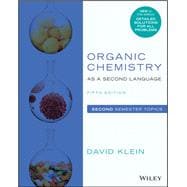Organic chemistry can be a challenging subject. Most students view organic chemistry as a subject requiring hours upon hours of memorization. Author David Klein’s Second Language books prove this is not true—organic chemistry is one continuous story that actually makes sense if you pay attention. Offering a unique skill-building approach, these market-leading books teach students how to ask the right questions to solve problems, study more efficiently to avoid wasting time, and learn to speak the language of organic chemistry.
The fifth edition of Organic Chemistry as a Second Language: Second Semester Topics builds upon the principles previously explored in first half of the course—delving deeper into molecular mechanisms, reactions, and analytical techniques. Hands-on exercises and thoroughly-explained solutions further reinforce student comprehension of chemical concepts and organic principles. An indispensable supplement to the primary text, this resource covers aromatic compounds, infrared (IR) and nuclear magnetic resonance (NMR) spectroscopy, nucleophilic and electrophilic aromatic substitution, ketones and aldehydes, carboxylic acid derivatives, and much more.
Chapter 1 Aromaticity 1
1.1 Introduction to Aromatic Compounds 1
1.2 Nomenclature of Aromatic Compounds 2
1.3 Criteria for Aromaticity 6
1.4 Lone Pairs 9
Chapter 2 IR Spectroscopy 11
2.1 Vibrational Excitation 11
2.2 IR Spectra 13
2.3 Wavenumber 13
2.4 Signal Intensity 18
2.5 Signal Shape 19
2.6 Analyzing an IR Spectrum 26
Chapter 3 NMR Spectroscopy 33
3.1 Chemical Equivalence 33
3.2 Chemical Shift (Benchmark Values) 36
3.3 Integration 41
3.4 Multiplicity 44
3.5 Pattern Recognition 46
3.6 Complex Splitting 48
3.7 No Splitting 49
3.8 Hydrogen Deficiency Index (Degrees of Unsaturation) 50
3.9 Analyzing a Proton NMR Spectrum 53
3.10 13C NMR Spectroscopy 57
Chapter 4 Electrophilic Aromatic Substitution 60
4.1 Halogenation and the Role of Lewis Acids 61
4.2 Nitration 65
4.3 Friedel–Crafts Alkylation and Acylation 67
4.4 Sulfonation 74
4.5 Activation and Deactivation 78
4.6 Directing Effects 80
4.7 Identifying Activators and Deactivators 89
4.8 Predicting and Exploiting Steric Effects 99
4.9 Synthesis Strategies 106
Chapter 5 Nucleophilic Aromatic Substitution 112
5.1 Criteria for Nucleophilic Aromatic Substitution 112
5.2 SNAr Mechanism 114
5.3 Elimination–Addition 120
5.4 Mechanism Strategies 125
Chapter 6 Ketones and Aldehydes 127
6.1 Preparation of Ketones and Aldehydes 127
6.2 Stability and Reactivity of C===O Bonds 130
6.3 H-Nucleophiles 132
6.4 O-Nucleophiles 137
6.5 S-Nucleophiles 147
6.6 N-Nucleophiles 149
6.7 C-Nucleophiles 157
6.8 Exceptions to the Rule 166
6.9 How to Approach Synthesis Problems 170
Chapter 7 Carboxylic Acid Derivatives 176
7.1 Reactivity of Carboxylic Acid Derivatives 176
7.2 General Rules 177
7.3 Acid Halides 181
7.4 Acid Anhydrides 189
7.5 Esters 191
7.6 Amides and Nitriles 200
7.7 Synthesis Problems 209
Chapter 8 Enols and Enolates 217
8.1 Alpha Protons 217
8.2 Keto-Enol Tautomerism 219
8.3 Reactions Involving Enols 223
8.4 Making Enolates 226
8.5 Haloform Reaction 229
8.6 Alkylation of Enolates 232
8.7 Aldol Reactions 236
8.8 Claisen Condensation 242
8.9 Decarboxylation 249
8.10 Michael Reactions 256
Chapter 9 Amines 263
9.1 Nucleophilicity and Basicity of Amines 263
9.2 Preparation of Amines Through SN2 Reactions 265
9.3 Preparation of Amines Through Reductive Amination 268
9.4 Acylation of Amines 273
9.5 Reactions of Amines with Nitrous Acid 276
9.6 Aromatic Diazonium Salts 279
Chapter 10 Diels–Alder Reactions 282
10.1 Introduction and Mechanism 282
10.2 The Dienophile 285
10.3 The Diene 286
10.4 Other Pericyclic Reactions 292
Detailed Solutions S-1
Index I-1

